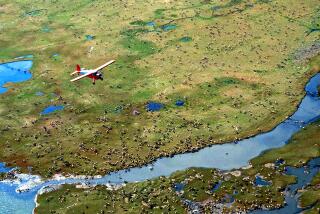Some Native Peoples See Dividends, Others See Disaster in Oil Drilling
- Share via
KAKTOVIK, Alaska — Warren Matumeak, a 63-year-old Inupiat Eskimo, recalls a time when his village was so poor that his family had to conserve what little seal oil it had to last through the long winters of the North Slope.
That meant as a child, Matumeak could not heat water on some sunless mornings--water that had frozen solid during the night. “Sometimes you’d go to school without even washing your face,” he said.
But Matumeak has seen his people prosper, the direct result of oil development on the North Slope. And leaders of Kaktovik, home to about 250 Inupiat Eskimos and the only settlement within the confines of the Alaska National Wildlife Refuge, now favor drilling in ANWR for the additional revenues it may mean.
“It has changed our lifestyle,” said Matumeak, an adviser to the native corporation that has mineral rights to land on the coastal plain. “Our health is better. We live longer. And our children are taken care of.”
A visitor to Kaktovik notices new snowmobiles and four-wheel all-terrain vehicles amid the stretched seal skins and dog sleds.
Although the village sits on tiny Barter Island in the Beaufort Sea, cut off from the rest of the state except by air, it boasts a modern medical clinic linked by satellite to other villages, a high school with a new gymnasium and indoor swimming pool, a senior center, a fire station and modern water-treatment and sewage plants.
If ANWR is developed, Kaktovik residents stand to make a lot more money, because the village and others hold subsurface rights to about 92,000 acres of land on the coastal plain.
Still, not everyone in the village favors opening ANWR. “I don’t want to get too civilized up here,” said Eddie Rexford, 32. “We have millions of wildlife up here. . . . It’s going to spoil the area, the habitat for the animals.”
And because the Inupiats’ subsistence diet is based on bowhead whales as well as on caribou, even proponents of drilling oppose any offshore development. “It would harm our garden, which is what the womenfolk say,” Matumeak said. “The sea is our garden.”
About 150 miles to the south, on the southern perimeter of ANWR, the Athabascan Indian residents of Arctic Village accuse the Inupiat of “selling out” to the oil industry.
The Indians, called the Gwich’in, have banded together with cousins from other villages in Alaska and Canada to protest development.
The Gwich’in fear that oil production will disrupt the calving patterns of the Porcupine caribou herd, upon which they have depended for generations.
If that happens, the herd’s migration could shift or even disappear--which would spell doom for the 120 or so villagers whose subsistence lifestyle depends almost exclusively on the animals.
“We consider ourselves caribou people,” said Sarah James, a village leader. “We identify ourselves with the herd. We’ve used it for thousands of years for tools, clothing, shelter, food--and we still use it.”
Arctic Village stands in stark contrast to Kaktovik. Rather than frame houses, the village has log cabins. There is a small clinic and a small school, but no sewage treatment plant.
The Gwich’in have no financial stake in ANWR development, and it’s unclear whether they would change their opinion if they did.
Said village postmaster Lincoln Tritt: “A lot of things we learn from the caribou are personal and spiritual values. . . . As far as that goes, you’re talking about pretty much wiping out our people.”
The scientific data on the effect of oil development on caribou is inconclusive.
The Central Arctic caribou herd has seen its numbers increase dramatically since development started in the 1970s. But recent data suggests that calving rates have begun to decline.
Still, it’s unclear whether the decline reflects weather, normal fluctuation or some undetermined effect of North Slope oil development, said Ken Whitten, a caribou research biologist with the Alaska Department of Fish and Game.
Nevertheless, environmentalists fear ANWR development would both displace the Porcupine herd and leave them no place to go.
Nonsense, say the oil companies. And besides, “let me be brutal about it,” said British Petroleum’s Roger Herrera. “Caribou are more plentiful than people in Alaska, so what’s the big deal?”
More to Read
Sign up for Essential California
The most important California stories and recommendations in your inbox every morning.
You may occasionally receive promotional content from the Los Angeles Times.










